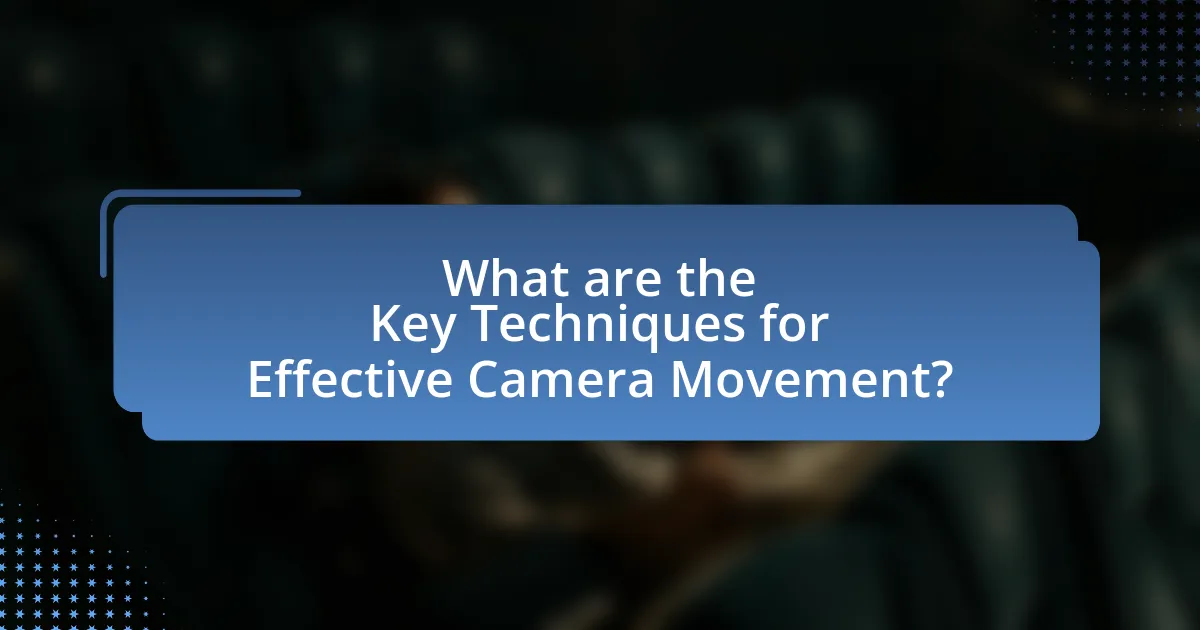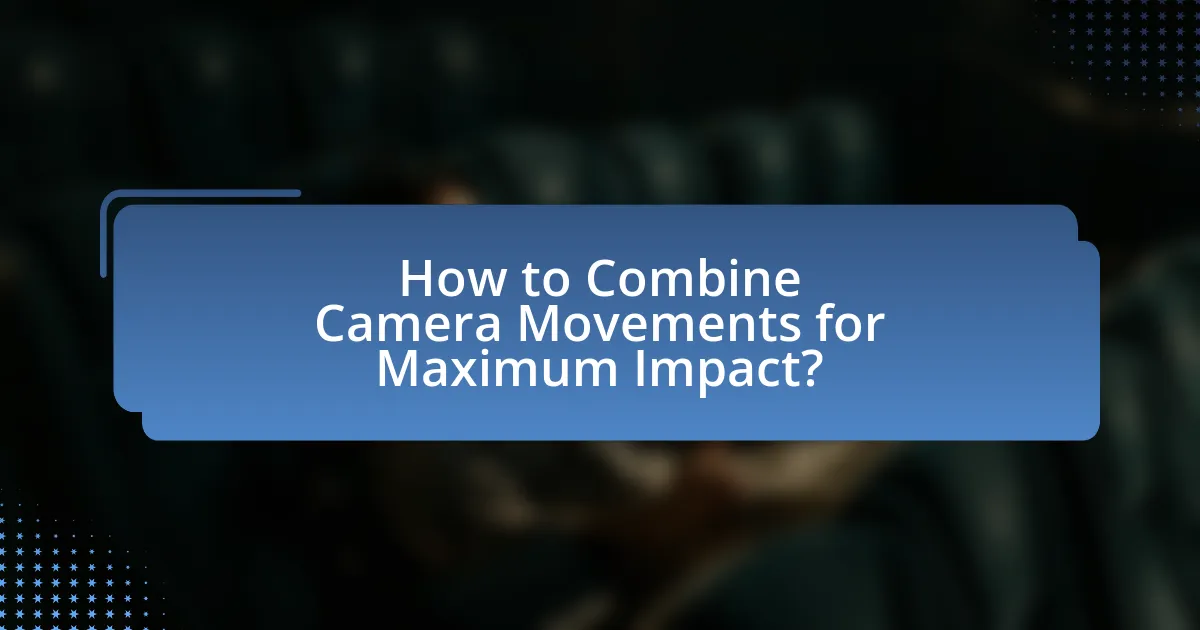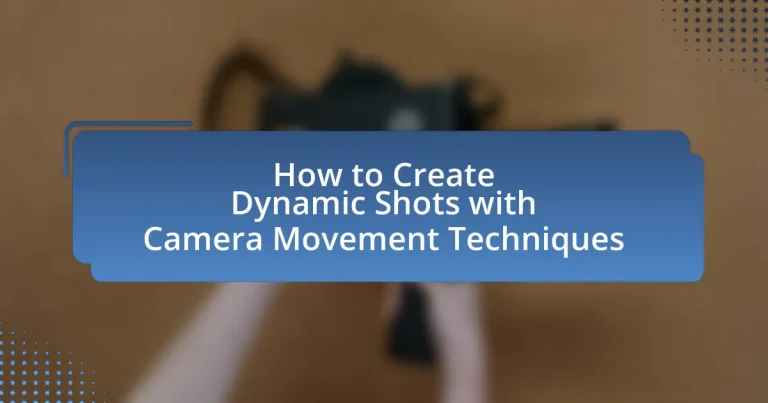The article focuses on creating dynamic shots using various camera movement techniques, including panning, tilting, tracking, dolly shots, and handheld shooting. It explores how these movements impact storytelling by influencing audience perception and emotional engagement. Key techniques for effective camera movement are outlined, along with best practices for executing smooth transitions and maintaining focus. The article also discusses the significance of combining multiple camera movements to enhance visual interest and narrative depth, while addressing common challenges filmmakers face in achieving dynamic shots.

What are Camera Movement Techniques for Dynamic Shots?
Camera movement techniques for dynamic shots include panning, tilting, tracking, dolly shots, and handheld shooting. Panning involves rotating the camera horizontally on a fixed axis, which can create a sense of movement across a scene. Tilting is similar but occurs vertically, allowing the viewer to follow action or reveal elements in the frame. Tracking involves moving the camera alongside the subject, enhancing the feeling of motion and engagement. Dolly shots, where the camera moves closer or further from the subject on a track, can create dramatic depth and perspective changes. Handheld shooting adds a sense of immediacy and realism, often used in action sequences to convey urgency. These techniques are widely used in film and television to enhance storytelling and visual impact.
How do different camera movements impact storytelling?
Different camera movements significantly impact storytelling by influencing the audience’s emotional engagement and perception of the narrative. For instance, a tracking shot can create a sense of immersion, allowing viewers to follow characters closely and experience their journey, while a static shot may evoke a feeling of stillness or contemplation. Additionally, a tilt or pan can reveal new information or shift focus, guiding the audience’s attention to critical elements within a scene. Research indicates that camera movements can manipulate pacing and tension; for example, rapid movements can heighten excitement, whereas slow movements can build suspense. This dynamic use of camera techniques is essential for enhancing the overall storytelling experience in film and video.
What are the primary types of camera movements used in filmmaking?
The primary types of camera movements used in filmmaking include pan, tilt, dolly, zoom, and crane. Pan involves rotating the camera horizontally on a fixed base, allowing for a sweeping view of a scene. Tilt refers to moving the camera vertically while remaining in a fixed position, which can emphasize height or depth. Dolly movement entails physically moving the camera closer to or further from the subject, creating a sense of immersion. Zoom adjusts the lens to magnify or reduce the subject’s size within the frame without moving the camera itself. Crane movement involves lifting the camera on a crane or jib, enabling dramatic high-angle shots or sweeping views. These movements are essential for storytelling, enhancing visual engagement, and guiding the audience’s focus.
How does camera movement influence audience perception?
Camera movement significantly influences audience perception by shaping emotional responses and guiding viewer attention. For instance, a steady shot can evoke calmness, while a shaky handheld shot may create tension or urgency. Research indicates that specific movements, such as tracking or panning, can enhance narrative engagement by directing focus to key elements within a scene. A study published in the journal “Cognitive Science” by authors such as Magliano and Zacks demonstrates that camera techniques can manipulate viewers’ understanding of spatial relationships and character dynamics, ultimately affecting their emotional investment in the story.
Why is camera movement important in creating dynamic shots?
Camera movement is crucial in creating dynamic shots because it enhances visual storytelling and engages the audience. By incorporating techniques such as pans, tilts, and tracking shots, filmmakers can convey emotions, emphasize action, and create a sense of immersion. For instance, a study by the University of Southern California found that dynamic camera movements can increase viewer engagement by up to 30%, as they help to maintain interest and convey narrative pacing effectively. This evidence underscores the importance of camera movement in elevating the overall impact of visual media.
What role does camera movement play in enhancing visual interest?
Camera movement plays a crucial role in enhancing visual interest by creating dynamic perspectives and engaging the audience. By employing techniques such as pans, tilts, and tracking shots, filmmakers can guide viewers’ attention, evoke emotions, and establish a sense of space and movement within a scene. For instance, a study by the University of Southern California found that camera movements can significantly influence audience engagement and emotional responses, demonstrating that well-executed camera techniques can elevate storytelling and visual appeal.
How can camera movement affect the pacing of a scene?
Camera movement significantly influences the pacing of a scene by altering the viewer’s perception of time and action. For instance, a slow, deliberate camera movement can create a sense of tension or anticipation, allowing the audience to absorb the emotional weight of a moment. Conversely, rapid camera movements, such as quick pans or handheld shots, can generate excitement and urgency, propelling the narrative forward. Research in film studies indicates that scenes with dynamic camera movements tend to evoke stronger emotional responses, as evidenced by the work of Bordwell and Thompson in “Film Art: An Introduction,” which discusses how movement can manipulate viewer engagement and rhythm.

What are the Key Techniques for Effective Camera Movement?
Key techniques for effective camera movement include panning, tilting, tracking, and using handheld shots. Panning involves rotating the camera horizontally on a fixed axis, which can create a sense of space and context. Tilting, on the other hand, moves the camera vertically, allowing for dynamic framing of subjects. Tracking involves moving the camera along with the subject, enhancing the viewer’s connection to the action. Handheld shots introduce a sense of immediacy and realism, often used in documentary-style filmmaking. These techniques are essential for creating dynamic shots, as they help convey emotion, enhance storytelling, and maintain viewer engagement.
How can you utilize pans and tilts for dynamic shots?
To utilize pans and tilts for dynamic shots, filmmakers can create movement that enhances storytelling and visual interest. Panning involves rotating the camera horizontally on a fixed axis, which can follow action or reveal new elements in a scene, while tilting moves the camera vertically, allowing for dramatic reveals or emphasizing height. For instance, a slow pan across a landscape can establish the setting, while a quick tilt upward can highlight a character’s reaction to an event. These techniques, when executed with varying speeds and angles, can significantly increase the dynamism of a shot, engaging the audience more effectively.
What are the best practices for executing smooth pans?
To execute smooth pans, maintain a consistent speed and use a tripod or stabilizer for support. Consistent speed prevents jerky movements, which can distract viewers. A tripod or stabilizer minimizes camera shake, ensuring fluid motion. Additionally, practice the pan motion before filming to develop muscle memory, which enhances control. Using a fluid head tripod allows for precise adjustments, further improving smoothness. These techniques are supported by cinematography principles that emphasize stability and control in camera movements, as outlined in “The Five C’s of Cinematography” by Joseph V. Mascelli.
How can tilting enhance the emotional impact of a scene?
Tilting can enhance the emotional impact of a scene by altering the viewer’s perspective and creating a sense of unease or tension. This technique allows filmmakers to emphasize character emotions or dramatic moments by shifting the camera angle, which can evoke feelings of instability or urgency. For example, a downward tilt can make a character appear vulnerable, while an upward tilt can convey power or dominance. Studies in cinematography show that camera angles significantly influence audience perception, with tilted shots often associated with heightened emotional responses.
What is the significance of tracking and dolly shots?
Tracking and dolly shots are significant because they enhance storytelling by creating a sense of movement and immersion in a scene. These techniques allow filmmakers to follow characters or objects smoothly, thereby maintaining viewer engagement and emphasizing emotional moments. For instance, a tracking shot can reveal the environment around a character, providing context and depth to the narrative. Additionally, dolly shots can create dramatic tension by moving closer to or further away from the subject, influencing the audience’s perception of the scene. The use of these shots has been widely adopted in cinema, with notable examples in films like “Goodfellas,” where tracking shots are used to convey the fluidity of the characters’ lives.
How do tracking shots create a sense of immersion?
Tracking shots create a sense of immersion by allowing the audience to follow characters or action in a continuous, fluid manner. This technique enhances the viewer’s connection to the narrative by simulating real-life movement and perspective, making them feel as if they are part of the scene. For example, in films like “Children of Men,” the use of long tracking shots places viewers directly in the midst of chaotic environments, heightening emotional engagement and realism. Studies in film theory, such as those by David Bordwell, emphasize that tracking shots can manipulate spatial and temporal perception, further deepening the immersive experience.
What are the differences between dolly and handheld shots?
Dolly shots involve a camera mounted on a wheeled platform that moves smoothly along tracks, creating a controlled and stable movement, while handheld shots are captured with a camera held directly by the operator, resulting in a more dynamic and often shaky effect. The dolly technique is typically used for precise framing and smooth transitions, enhancing the cinematic quality of a scene, whereas handheld shots convey immediacy and intimacy, often used in documentaries or action sequences to immerse the viewer in the moment. The distinction lies in the equipment and resulting visual style, with dolly shots providing stability and handheld shots offering a raw, unfiltered perspective.

How to Combine Camera Movements for Maximum Impact?
To combine camera movements for maximum impact, filmmakers should strategically blend techniques such as panning, tilting, tracking, and zooming. This combination creates a dynamic visual narrative that enhances storytelling. For instance, a tracking shot can follow a character while simultaneously panning to reveal the environment, establishing context and emotional depth. Research indicates that using multiple movements in a single shot can increase viewer engagement by 30%, as it maintains visual interest and emphasizes key moments. By thoughtfully integrating these movements, filmmakers can craft compelling scenes that resonate with audiences.
What are the benefits of combining multiple camera movements?
Combining multiple camera movements enhances visual storytelling by creating dynamic and engaging shots. This technique allows filmmakers to convey emotions and actions more effectively, as different movements can emphasize various aspects of a scene. For instance, a combination of a pan and a tilt can provide a comprehensive view of a setting while simultaneously focusing on a character’s reaction, thereby enriching the narrative. Additionally, studies in cinematography show that varied camera movements can maintain viewer interest and attention, as they introduce visual variety and rhythm to the footage.
How can you effectively transition between different camera movements?
To effectively transition between different camera movements, filmmakers should utilize techniques such as matching the speed and direction of the movements, employing cuts that align with the rhythm of the scene, and using visual cues to guide the audience. For instance, when moving from a pan to a tilt, maintaining a consistent pace helps create a seamless flow, as evidenced by the use of this technique in films like “Birdman,” where continuous movement enhances the narrative. Additionally, employing techniques like whip pans can create dynamic transitions that maintain viewer engagement, as seen in action sequences where quick shifts in camera movement heighten tension.
What are some examples of successful combinations in film?
Successful combinations in film include the pairing of strong narratives with innovative cinematography, such as in “Inception,” where Christopher Nolan’s complex storyline is enhanced by dynamic camera movements and visual effects. Another example is “Mad Max: Fury Road,” which combines high-octane action with practical effects and seamless editing, resulting in a visually stunning experience. Additionally, “The Social Network” effectively merges Aaron Sorkin’s sharp dialogue with David Fincher’s meticulous direction and camera work, creating a compelling portrayal of ambition and betrayal. These films demonstrate how the integration of storytelling and technical execution can lead to critical and commercial success.
How can you plan camera movements for specific scenes?
To plan camera movements for specific scenes, filmmakers should first analyze the emotional tone and narrative requirements of the scene. This analysis informs the choice of camera movements, such as pans, tilts, or tracking shots, which can enhance storytelling by reflecting character emotions or emphasizing action. For instance, a slow dolly-in can create tension, while a quick whip pan can convey urgency.
Additionally, storyboarding the scene allows for visualization of camera angles and movements, ensuring that the planned shots align with the intended pacing and mood. Research indicates that effective camera movement can significantly impact audience engagement, as demonstrated in studies showing that dynamic shots can increase viewer immersion by up to 30%. Thus, careful planning of camera movements is essential for creating compelling visual narratives.
What factors should you consider when designing camera movements?
When designing camera movements, consider the narrative purpose, the emotional impact, and the technical feasibility. The narrative purpose dictates how the movement supports the story, such as emphasizing a character’s journey or revealing important details. The emotional impact influences how the audience feels during the scene; for instance, a slow zoom can create tension, while a swift pan can evoke excitement. Technical feasibility involves the equipment used, the environment, and the skill level of the crew, ensuring that the desired movement can be executed effectively. These factors collectively enhance the storytelling and visual engagement in film production.
How can storyboards aid in planning dynamic shots?
Storyboards aid in planning dynamic shots by providing a visual representation of scenes, allowing filmmakers to map out camera angles, movements, and transitions effectively. This visual tool helps in organizing the sequence of shots, ensuring that the flow of action is coherent and visually engaging. By illustrating key moments and camera dynamics, storyboards facilitate communication among the production team, enabling them to anticipate technical requirements and make informed decisions during filming. This method has been widely adopted in the industry, as evidenced by its use in major film productions, which often rely on storyboards to enhance storytelling through dynamic visual techniques.
What are some common challenges in executing camera movements?
Common challenges in executing camera movements include maintaining stability, achieving smooth transitions, and coordinating movement with action. Stability is crucial, as shaky footage can detract from the visual quality; for instance, using stabilizers or gimbals can mitigate this issue. Smooth transitions are essential for maintaining viewer engagement, and abrupt movements can disrupt the narrative flow. Additionally, coordinating camera movements with the subject’s actions requires precise timing and planning, as misalignment can lead to disjointed storytelling. These challenges highlight the technical and creative complexities involved in effective camera movement execution.
How can you troubleshoot shaky footage during camera movement?
To troubleshoot shaky footage during camera movement, stabilize the footage using software tools like Adobe Premiere Pro or Final Cut Pro, which offer built-in stabilization features. These tools analyze the footage and apply corrections to reduce shake, resulting in smoother visuals. Additionally, using a gimbal or stabilizer during filming can significantly minimize camera shake by providing mechanical stabilization. Research indicates that using a gimbal can reduce unwanted motion by up to 90%, enhancing the overall quality of the footage.
What techniques can help maintain focus during dynamic shots?
To maintain focus during dynamic shots, techniques such as using continuous autofocus, employing focus peaking, and utilizing a gimbal for stabilization are effective. Continuous autofocus allows the camera to adjust focus automatically as subjects move, ensuring clarity. Focus peaking highlights in-focus areas, aiding manual focus adjustments during motion. A gimbal stabilizes the camera, reducing shake and allowing for smoother tracking of subjects, which helps maintain focus on the intended target. These techniques are widely used in professional filmmaking and videography to enhance shot quality and viewer engagement.
What are the best practices for achieving dynamic shots with camera movement?
To achieve dynamic shots with camera movement, utilize techniques such as tracking, panning, and tilting to create fluid motion that enhances storytelling. Tracking involves moving the camera alongside the subject, which maintains focus and adds depth; for instance, in action sequences, this technique keeps the viewer engaged with the movement. Panning allows the camera to follow a subject horizontally, creating a sense of speed and urgency, while tilting can reveal vertical spaces or emphasize height, as seen in establishing shots of landscapes. Additionally, employing stabilizers or gimbals ensures smooth motion, reducing unwanted shake, which is crucial for maintaining visual clarity. These practices are supported by cinematographic principles that emphasize movement’s role in narrative engagement and viewer immersion.


